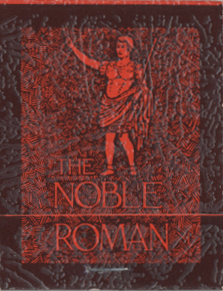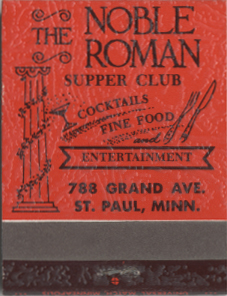Difference between revisions of "The Noble Roman"
(table +table) |
|||
| Line 4: | Line 4: | ||
| − | |||
| + | {| {{prettytable}} | ||
| + | ! | ||
| + | ! | ||
| + | |- | ||
| + | | <div style="text-align: center;"> | ||
| + | [[Image:Svc_noblerofront.jpg]] | ||
| + | </div> <div style="text-align: center;"> | ||
| + | <small>'''Noble Roman matchbook (front), Courtesy of the [[Jean-Nickolaus Tretter Collection]].'''</small> | ||
| + | </div> | ||
| + | | Mary Kester created the Noble Roman when she turned a Grand Avenue supper club to a gay bar in 1970. | ||
| − | |||
| + | Along with the Town House Bar, the “Roman” was part community center, part dance club, and part neighborhood bar that served St. Paul’s queer community before many bars were LGBT-owned. The Roman was particularly popular because its heterosexual owner was overwhelmingly concerned with profit; she left event planning and day-to-day management to the all-gay staff. Kester’s lax attitude permitted the bar’s popular free stage—the venue hosted innumerable drag acts, politely-received ventriloquism shows, and musical numbers. | ||
| + | |} | ||
| − | The owner’s carefree management style had positive and negative effects on the community. The Noble Roman was an early site of faux gay weddings, and drag queens received a small stipend for their Sunday performances on its free stage. When it came to paying bills, her ownership was detrimental—the bar closed several times due to mortgage truancy. Patrons even stole the bar’s furniture to furnish their apartments; there was “noticeably less” seating as time progressed. Kessler eventually saw profit in selling the bar, and she sold it to owners that promptly returned the establishment to a straight bar in 1976. | + | |
| + | Jean-Nickolaus Tretter, now the director of the Jean-Nickolaus Tretter Collection, worked at the bar during its operation. Tretter and coworker Patrick Bradley used the stager for a piano bar routine on quiet Monday and Tuesday nights—the duo gathered a small following and eventually played at the 1973 [[Twin Cities Pride Festival]]. | ||
| + | |||
| + | |||
| + | He recalls one of the stage’s most memorable performances—a fire dance routine—that ended with its hairy dancer “singed” but otherwise unharmed. His act resulted in raucous laughter, as did the frequent spills of intoxicated patrons who could not avoid the bar’s substantial water fountain near the entrance. Truly, one could not call themselves a regular until they took this “swim.” | ||
| + | |||
| + | {| {{prettytable}} | ||
| + | ! | ||
| + | ! | ||
| + | |- | ||
| + | | The owner’s carefree management style had positive and negative effects on the community. The Noble Roman was an early site of faux gay weddings, and drag queens received a small stipend for their Sunday performances on its free stage. When it came to paying bills, her ownership was detrimental—the bar closed several times due to mortgage truancy. | ||
| + | |||
| + | |||
| + | Patrons even stole the bar’s furniture to furnish their apartments; there was “noticeably less” seating as time progressed. Kessler eventually saw profit in selling the bar, and she sold it to owners that promptly returned the establishment to a straight bar in 1976. | ||
| + | | <div style="text-align: center;"> | ||
| + | [[Image:Svc_nobleroback.jpg]] | ||
| + | </div> <div style="text-align: center;"> | ||
| + | <small>'''Noble Roman matchbook (front), Courtesy of the [[Jean-Nickolaus Tretter Collection]].'''</small> | ||
| + | </div> | ||
| + | |} | ||
Revision as of 16:22, 17 March 2010
788 Grand Avenue, St. Paul, MN. (1970-1976)
| Noble Roman matchbook (front), Courtesy of the Jean-Nickolaus Tretter Collection. |
Mary Kester created the Noble Roman when she turned a Grand Avenue supper club to a gay bar in 1970.
|
Jean-Nickolaus Tretter, now the director of the Jean-Nickolaus Tretter Collection, worked at the bar during its operation. Tretter and coworker Patrick Bradley used the stager for a piano bar routine on quiet Monday and Tuesday nights—the duo gathered a small following and eventually played at the 1973 Twin Cities Pride Festival.
He recalls one of the stage’s most memorable performances—a fire dance routine—that ended with its hairy dancer “singed” but otherwise unharmed. His act resulted in raucous laughter, as did the frequent spills of intoxicated patrons who could not avoid the bar’s substantial water fountain near the entrance. Truly, one could not call themselves a regular until they took this “swim.”
| The owner’s carefree management style had positive and negative effects on the community. The Noble Roman was an early site of faux gay weddings, and drag queens received a small stipend for their Sunday performances on its free stage. When it came to paying bills, her ownership was detrimental—the bar closed several times due to mortgage truancy.
|
Noble Roman matchbook (front), Courtesy of the Jean-Nickolaus Tretter Collection. |
Information for this page is the result of an interview with Jean-Nickolaus Tretter, who worked as bar staff at the Noble Roman for much of its existence.
This page is still under construction. -SVC.
Part of Minneapolis/St. Paul, MN: 100 Queer Places in Minnesota History, (1860-1969), (1969-2010)

